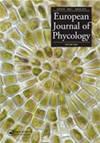新喀里多尼亚发现的十种新的Ulva(Ulvophyceae,Chlorphyta):遗传和形态多样性,以及开花潜力
IF 1.7
4区 生物学
Q2 MARINE & FRESHWATER BIOLOGY
引用次数: 11
摘要
Ulva是一种绿色大藻属,物种多样性丰富,分布在世界各地。目前对榆科植物多样性的认识主要集中在温带地区,而热带和亚热带地区的遗传和形态资料很少,物种丰富度也没有明确的定义。该属以其形成水华的能力而闻名,它可以引起绿潮,导致严重的环境和经济破坏。在过去的二十年里,新喀里多尼亚发生了几次重要的Ulva属植物的繁殖,需要进一步的调查来确定涉及的物种。由于对新喀里多尼亚乌尔瓦多样性的了解有限,因此对该地区乌尔瓦物种的更新是至关重要的。基于在新喀里多尼亚(Grande Terre, Pines和Loyalty Islands)收集的Ulva标本,我们(1)通过物种划分方法重新评估了物种多样性,(2)分析了形态解剖特征,以确定物种和/或丰富其诊断,(3)重建了该属的多位点系统发育(ITS, rbcL, tufA)。共发现21个次级物种假说(SSHs),其中5个被成功归类为U. lactuca、U. ohnoi、U. tepida、U. meridionalis和U. taeniata。其中10种被定义为新种,并提供了分类描述,另外6种为单种,需要进行数据丰富以更好地解释。我们的串联多位点矩阵包括61个Ulva种。其中,在新喀里多尼亚发现了15种,并得到了中等到强烈的支持。在新喀里多尼亚发现的Ulva物种中,已知有七种会形成水华,这突出了对水质的严格监管和定期监测的必要性,特别是在这些物种可能形成绿潮的高营养输入地区。对新喀里多尼亚的Ulva多样性进行了重新评估,其中突出显示了15个物种。在新喀里多尼亚发现了十个新物种。本地物种引起了新喀里多尼亚最近的绿潮。本文章由计算机程序翻译,如有差异,请以英文原文为准。
Ten new species of Ulva (Ulvophyceae, Chlorophyta) discovered in New Caledonia: genetic and morphological diversity, and bloom potential
ABSTRACT Ulva is a green macroalgal genus with rich species diversity and worldwide distribution. While current knowledge on Ulva diversity focuses on temperate regions, genetic and morphological data in tropical and subtropical areas are scarce and the species richness is not clearly defined. The genus is known for its bloom-forming ability that can induce green tides leading to severe environmental and economic damage. In the last two decades, several important blooms of Ulva spp. have occurred in New Caledonia, requiring further investigations to identify the species involved. As knowledge of New Caledonian Ulva diversity is limited, an update to the Ulva spp. inventory in the area is essential. Based on Ulva specimens collected throughout New Caledonia (Grande Terre, Isle of Pines and Loyalty Islands), we (1) reassessed species diversity using species delimitation methods, (2) analysed morpho-anatomical characters to identify species and/or enrich their diagnosis, and (3) reconstructed a multilocus phylogeny (ITS, rbcL, tufA) of the genus. We found 21 secondary species hypotheses (SSHs) among our dataset, from which five were successfully assigned to U. lactuca, U. ohnoi, U. tepida, U. meridionalis and U. taeniata. Ten SSHs were defined as new species for which we provided taxonomic description, and six other SSHs were singletons that will need to be data-enriched for better interpretation. Our concatenated multilocus matrix included 61 Ulva species. Of these, 15 species were found in New Caledonia and were moderately to strongly supported. Among the Ulva species found in New Caledonia, seven are known to be bloom-forming which highlights the need for strict regulation and regular monitoring of water quality, particularly in areas exposed to strong nutrient input where these species can form green tides. Highlights Ulva diversity in New Caledonia was reassessed with 15 species highlighted. Ten new species have been discovered in New Caledonia. Indigenous species caused recent green tides in New Caledonia.
求助全文
通过发布文献求助,成功后即可免费获取论文全文。
去求助
来源期刊

European Journal of Phycology
生物-海洋与淡水生物学
CiteScore
4.80
自引率
4.20%
发文量
37
审稿时长
>12 weeks
期刊介绍:
The European Journal of Phycology is an important focus for the activities of algal researchers all over the world. The Editors-in-Chief are assisted by an international team of Associate Editors who are experts in the following fields: macroalgal ecology, microalgal ecology, physiology and biochemistry, cell biology, molecular biology, macroalgal and microalgal systematics, applied phycology and biotechnology. The European Journal of Phycology publishes papers on all aspects of algae, including cyanobacteria. Articles may be in the form of primary research papers and reviews of topical subjects.
The journal publishes high quality research and is well cited, with a consistently good Impact Factor.
 求助内容:
求助内容: 应助结果提醒方式:
应助结果提醒方式:


